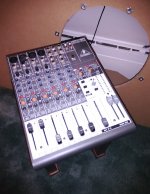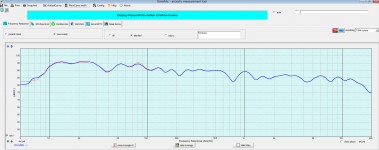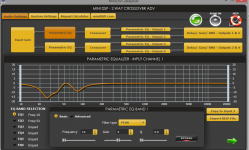If you are considering returning the Rolls there are units you can buy that don't need any modification. Like I said, research. Mark said he had a list, maybe you might consider that.
Amazon does have a great return policy. So I could. But I don't want to spend hundreds of dollars. If someone knows of something that would do what is needed at a reasonable price without modification, that would get my attention.
BO
OK. Here's the printout from the REW measurement I did today.
I ran sweeps from 16 to 64 Hertz. The mike was about six feet from the cone, and slightly off to the side - positioned on a mike stand about 4 feet above the floor. This was in a Sunday school room just off from the Sanctuary. The XLS1500 was in bridged mode with the gain knob set at about 70%.
I still get an error in REW saying the input is very low. So this may be totally useless. But some wanted to see this.
I did not want to move the cabinet while the caulk was still drying, so I did not take it outside.
SPL and Phase
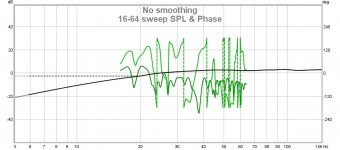
Distortion
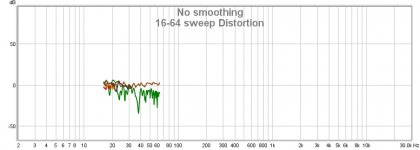
Bach On
I ran sweeps from 16 to 64 Hertz. The mike was about six feet from the cone, and slightly off to the side - positioned on a mike stand about 4 feet above the floor. This was in a Sunday school room just off from the Sanctuary. The XLS1500 was in bridged mode with the gain knob set at about 70%.
I still get an error in REW saying the input is very low. So this may be totally useless. But some wanted to see this.
I did not want to move the cabinet while the caulk was still drying, so I did not take it outside.
SPL and Phase

Distortion

Bach On
Getting there.
Not sure why the input signal is low. Yes, it can render the curves questionable, esp. the distortion. Any chance you are reading your computer's mic rather than the plug-in mic or other controls on input?
Start sweep as low as REW goes (15 Hz, I think) and run it higher for context, like 200 Hz.
No need to show mic correction curve. Or phase.
But the scale needs to be enlarged (the little pictographs near the upper left corner, inside the graph box). You need to be able to read say, 10 dB or 5 dB bars.
Smoothing is a matter of taste. Using 1/12 is a good compromise between hiding the random flux without hiding the real performance.
Too bad nobody has offered to visit you and give you a hand in person.
Ben
Not sure why the input signal is low. Yes, it can render the curves questionable, esp. the distortion. Any chance you are reading your computer's mic rather than the plug-in mic or other controls on input?
Start sweep as low as REW goes (15 Hz, I think) and run it higher for context, like 200 Hz.
No need to show mic correction curve. Or phase.
But the scale needs to be enlarged (the little pictographs near the upper left corner, inside the graph box). You need to be able to read say, 10 dB or 5 dB bars.
Smoothing is a matter of taste. Using 1/12 is a good compromise between hiding the random flux without hiding the real performance.
Too bad nobody has offered to visit you and give you a hand in person.
Ben
This may have been said but I vote for taking a voltage measurement at the amp at 16 Hz, then at 60 Hz -- Just to see any expected rolloff, if one can plot the electrical rolloff - it gets rather easy to EQ it electrically flat. I had an issue a while back with my home theater reciever crossing over my Pro EQ'ed sub lower than I was expecting, found out doing a very similar thing as I mentioned except for me it was comparing 100 Hz with 50 Hz.
That capacitor is a part of a RC filter that, as we all (?) know, has a 6 dB/octave slope. Big reason for an alarm.what if some component says it protects speakers below 30 Hz. That means they installed a large very, very, very loosely rated capacitor with a nominal value that starts to operate around 20 Hz, maybe, and cuts at 3 dB/8ave. Big deal. Certainly no reason to alarm Bach On. Not sensible.
Ben
This may have been said but I vote for taking a voltage measurement at the amp at 16 Hz, then at 60 Hz -- Just to see any expected rolloff, if one can plot the electrical rolloff - it gets rather easy to EQ it electrically flat. I had an issue a while back with my home theater reciever crossing over my Pro EQ'ed sub lower than I was expecting, found out doing a very similar thing as I mentioned except for me it was comparing 100 Hz with 50 Hz.
I'm with Sabaspeed521; easy to measure and fix later.
And about time to air a little secret: "house curve" (which is a euphemism for "crank up the bass till it sounds right"). Ultimately, somebody will want to make this speaker much louder than "mic flat" - so that it sounds right (since various threads at DIYaudio have revealed that many (most, all...) do crank up the bass esp with EQ)*.
Which brings me to a mixing board, possibly needed to adjust mic output and later for getting various voices into the new speaker. Flexibility makes doing REW measurements a joy. Cheap second-hand (around $70) since a million sold to amateur DJs and bands. Phantom power. Not sure if this fits into Bach On's mic set-up but might be helpful later on for running the speaker.
See picture with familiar 15-inch hole and tee-nuts for scale behind the mixer.
Ben
*ummm, not sure how that fits into a sim; the famous Altec "Voice of the Theater" had a wonkee "alignment" that emphasized the upper resonance bump because that sounded right to a gazillion viewers of "Jaws" movie; just why would anybody design a speaker to be flat when everybody wants to boost the bass?
Attachments
Last edited:
just why would anybody design a speaker to be flat when everybody wants to boost the bass?
Probably because of how room dependent everything is below a couple hundred cycles, building in too much "niceness" could make room issues worse. For example, in my room..with the subs positioned how they are, all the EQ I use below about 30 (more than that, now that I'm looking at it) is ALL subtraction.
If these subs had been designed with my "niceness" slanted response, I wouldn't have enough leeway in EQ to fix them.
Attachments
@BO
I'm so tempted to say something about body odour, oops!
I think Ben may have hit the nail on the head. You may or may not be measuring with your proper microphone.
The fluctuations on the measurement are pretty much normal. You can remove the phase data if you wish by setting this button:
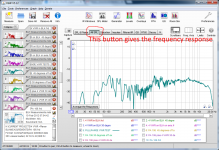
I give you this to make you feel better. I did this measurement years ago, and my first shot at REW. It's way down in the basement like yours!
If I understand your setup correctly. You are using an outboard mic preamp/converter connected with a USB cable to your laptop.
When you plug it into your computer does it recognize the new outboard sound card?
You can check this by going to control panel:

Then Sound.
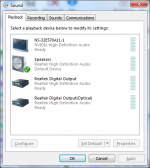
And you will see a box come up that looks like this.
From your manual:
Once the USB connection is made and your computer is on, the USB interface circuitry will be powered by your computer over the USB bus and the unit will automatically connect and try to set your computer “Default Audio Device” to be “USB Audio CODEC”. Usually the computer will do this automatically whenever a USB device is first connected, but it is sometimes necessary to make the selection manually. The same settings may need to be made in your particular audio application as well (Check your application instructions). These settings should be made while the two units are connected and powered on. Select one of the following sound recording (input) settings: WINDOWS 98SE: Settings => Control Panel => Multimedia Choose the preferred device: “USB Audio Device” WINDOWS XP: Settings => Control Panel => Sounds and Audio Devices => Audio. Choose the mixer device: “USB Audio CODEC” or Programs =>Accessories =>Entertainment =>Volume Control=> Options=> Properties Choose the mixer device: “USB Audio CODEC”. WINDOWS VIsta: Settings => Control Panel => Sound => Playback Tab and Record Tab. Choose: “USB Audio CODEC”
From me. Make sure your phantom power button on the back is on. Your microphone needs power to operate.
As for setting up REW there is a pretty good manual in the program. If you need help let me know. I have been known to get people through these things from time to time.
The trick is to lead them deep into the mud and leave them in the deepest part of the puddle. Sink or swim!😀
I'm so tempted to say something about body odour, oops!
I think Ben may have hit the nail on the head. You may or may not be measuring with your proper microphone.
The fluctuations on the measurement are pretty much normal. You can remove the phase data if you wish by setting this button:

I give you this to make you feel better. I did this measurement years ago, and my first shot at REW. It's way down in the basement like yours!
If I understand your setup correctly. You are using an outboard mic preamp/converter connected with a USB cable to your laptop.
When you plug it into your computer does it recognize the new outboard sound card?
You can check this by going to control panel:

Then Sound.

And you will see a box come up that looks like this.
From your manual:
Once the USB connection is made and your computer is on, the USB interface circuitry will be powered by your computer over the USB bus and the unit will automatically connect and try to set your computer “Default Audio Device” to be “USB Audio CODEC”. Usually the computer will do this automatically whenever a USB device is first connected, but it is sometimes necessary to make the selection manually. The same settings may need to be made in your particular audio application as well (Check your application instructions). These settings should be made while the two units are connected and powered on. Select one of the following sound recording (input) settings: WINDOWS 98SE: Settings => Control Panel => Multimedia Choose the preferred device: “USB Audio Device” WINDOWS XP: Settings => Control Panel => Sounds and Audio Devices => Audio. Choose the mixer device: “USB Audio CODEC” or Programs =>Accessories =>Entertainment =>Volume Control=> Options=> Properties Choose the mixer device: “USB Audio CODEC”. WINDOWS VIsta: Settings => Control Panel => Sound => Playback Tab and Record Tab. Choose: “USB Audio CODEC”
From me. Make sure your phantom power button on the back is on. Your microphone needs power to operate.
As for setting up REW there is a pretty good manual in the program. If you need help let me know. I have been known to get people through these things from time to time.
The trick is to lead them deep into the mud and leave them in the deepest part of the puddle. Sink or swim!😀
sabaspeed521 makes sense.
Almost any meter will accurately measure the voltage differences in frequency. And you can use REW to generate a sine wave at a given frequency.
Decibels to Voltage Gain and Loss convert calculation conversion amplification amplifier electronics - sengpielaudio Sengpiel Berlin
This link will help you convert a voltage measurement to a decibel measurment.
Then you will have a good idea what to do, if you need to compensate for your amplifier having a roll off.
As Zero D said, they are good at not giving the specs that you really need, like power bandwidth.
Almost any meter will accurately measure the voltage differences in frequency. And you can use REW to generate a sine wave at a given frequency.
Decibels to Voltage Gain and Loss convert calculation conversion amplification amplifier electronics - sengpielaudio Sengpiel Berlin
This link will help you convert a voltage measurement to a decibel measurment.
Then you will have a good idea what to do, if you need to compensate for your amplifier having a roll off.
As Zero D said, they are good at not giving the specs that you really need, like power bandwidth.
Bach On
Just ordered 10 uF 32 volt Electrolytic Caps.
Good for you 🙂 Don't hesitate to ask for assistance, Before you start de/soldering etc.
Got other tasks for today. But I'll take a meter over on Wed. to do the measurement suggested.
This program (REW) and the TrueRTA program both see the outboard sending unit. I do have the button for Phantom Power on. Turning it Off eliminates the signal.
You have to set the Input options and the Output options under preferences in REW. I'm pretty confident I've set the mike input for the ART Dual Pre. Switching between Left and Right channels changes the input source. Using Left, I get an input. Using Right gets no input since the mike is plugged into the Left connector.
I have two Behringher mixers, Ben. So if you're suggesting I use one of these as a converter, I can do so.
Mark, the temps are very hot and humid outside around here in July. So I may very well have body odor.
Bach On
This program (REW) and the TrueRTA program both see the outboard sending unit. I do have the button for Phantom Power on. Turning it Off eliminates the signal.
You have to set the Input options and the Output options under preferences in REW. I'm pretty confident I've set the mike input for the ART Dual Pre. Switching between Left and Right channels changes the input source. Using Left, I get an input. Using Right gets no input since the mike is plugged into the Left connector.
I have two Behringher mixers, Ben. So if you're suggesting I use one of these as a converter, I can do so.
Mark, the temps are very hot and humid outside around here in July. So I may very well have body odor.
Bach On
Mark, the temps are very hot and humid outside around here in July. So I may very well have body odor
I hear you. It's cracking 30 degrees Celsius here today to. Google tells me that's 86 F.
Still nothing close to when I was working in Guangzhou last summer. 42 degrees Celsius was the hottest and 27 was the coolest. Almost 100% humditity to boot.
Lovely weather!
I have two Behringher mixers, Ben. So if you're suggesting I use one of these as a converter, I can do so.
Bach On
Ah spring in Guangzhou... no doubt food as good as the Hong Kong cuisine in Toronto.
Having a mixer in-line can provide amplification, LED voltage reading to show mic loudness, phantom power, XLR and RCA connections, tone controls (heaven forbid), ability to patch in electric signals (like the cable that goes into the amp... so you can see what you are putting into the amp quite precisely and to see if there's distortion.... a very point to check, although the speaker terminals is where the rubber meets the pavement).
And useful later on in setting up (or enduring) in the system.
Ben
Probably because of how room dependent everything is below a couple hundred cycles, building in too much "niceness" could make room issues worse. For example, in my room..with the subs positioned how they are, all the EQ I use below about 30 (more than that, now that I'm looking at it) is ALL subtraction.
If these subs had been designed with my "niceness" slanted response, I wouldn't have enough leeway in EQ to fix them.
I'm as pagan as many others in enjoying good bass. But I generally set the EQ on my car stereo to be flat. Then I play the music with the volume turned up.
Bach On
Probably because of how room dependent everything is below a couple hundred cycles, building in too much "niceness" could make room issues worse/QUOTE]
I don't know why your bass speaker is playing louder than the rest of the system. Lots of reasons.
But your "house curve" has 10 DB of boost in the bass*. QED.
BTW, your FR curve is pretty smoothed. What smoothing?
Ben
*yeah, mine about the same to sound right to me
Last edited:
A mixer is good only if you can keep the little fingers from resetting it.
Locked away where no one will get to it.
When anyone sees a mixer they have an irresistible urge to move the sliders and twiddle the knobs.
Locked away where no one will get to it.
When anyone sees a mixer they have an irresistible urge to move the sliders and twiddle the knobs.
I'm with Sabaspeed521; easy to measure and fix later.
Why not do it now? At least you are not insisting it isn't a problem anymore, but it's weird that you want to postpone fixing a known issue.
And about time to air a little secret: "house curve" (which is a euphemism for "crank up the bass till it sounds right"). Ultimately, somebody will want to make this speaker much louder than "mic flat" - so that it sounds right (since various threads at DIYaudio have revealed that many (most, all...) do crank up the bass esp with EQ)*.
Again, really weird. After suggesting several things that would CUT the bass level by several db (like sealed box, not worrying about the leak, not fixing the DI box response, etc), now you concede that even flat bass is often not enough.
Ben
*ummm, not sure how that fits into a sim; the famous Altec "Voice of the Theater" had a wonkee "alignment" that emphasized the upper resonance bump because that sounded right to a gazillion viewers of "Jaws" movie; just why would anybody design a speaker to be flat when everybody wants to boost the bass?
As the good Dr pointed out, the room changes everything. Trying to add a bass bump to a particular design that will be used in many different environments, or even if it's a permanent installation in a single room (without knowing the details of the room gain curve it's going into) is pretty dumb. What if your bumped up response corresponds to a room mode? Then you have 15, 20, 25, maybe 30 db peak in the bass.
BUT if you wanted to you absolutely could design in a bass bump. The simulator will let you adjust almost anything you want - with Hornresp you can adjust eq, filters, and you can even input a .frd of the room gain curve so you can create a sub with inverse response for a flat overall in room response, OR you can add any bump (or any response curve shape) you want.
I'm not sure why you keep mentioning sims in every other post now - it feels like you are just mentioning random things that you think a sim can't do to show how ineffective they are. In this case, the sim CAN do that. And quite a few other things.
A mixer is good only if you can keep the little fingers from resetting it.
Locked away where no one will get to it.
When anyone sees a mixer they have an irresistible urge to move the sliders and twiddle the knobs.
I will not use a mixer as part of the permanent setup. First, I don't think it will be needed. Second, it is just another component that could go bad; adding distortion and other extra noise like hum, etc..
I only meant I could use the mixer to temporarily increase the input to the amp beyond the 0.7 volts of the consumer grade components. Of course the question is will a mixer have the low bass cutoff that the ART, Rolls, ad infinitum have?
Bach On
Last edited:
- Status
- Not open for further replies.
- Home
- Loudspeakers
- Subwoofers
- 16Hz for church organ
